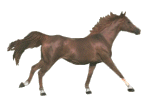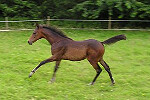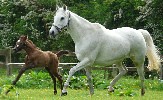| Author |
 Topic Topic  |
|
|
|
susan p
Gold Member
   
 Scotland Scotland
915 Posts |
 Posted - 07 Oct 2010 : 12:59:28 PM Posted - 07 Oct 2010 : 12:59:28 PM





|
Colour genetics experts advice needed,if I put my grey mare Iana to a homozygous black stallion,what are my chances of getting a black foal?
Her sire was bay and her dam grey,she was dark as a youngster and has dark skin 
|

www.blackislearabians.com
The greatness of a nation and its moral progress can be judged by the ways its animals are treated
|
|
Report to moderator
|
|
|
ella
Gold Member
   

United Kingdom
786 Posts |
 Posted - 07 Oct 2010 : 1:37:49 PM Posted - 07 Oct 2010 : 1:37:49 PM





|
As I currently understand colour genetics your probability of a black foal is between 0-50%.
It all depends what 'colour' genes your mare inherited as well as her grey gene. If she is a black or chestnut turned grey, there is a 50% chance of a black foal, 50% chance of a grey foal.
If she is a bay turned grey there is 50% chance of a grey foal, 50% chance of a bay. |
   
"If an 'alternative treatment' has reliable effect it becomes classified simply as MEDICINE" D.B. |
Report to Moderator  |
|
|
Pashon2001
Platinum Member
    

3575 Posts |
 Posted - 07 Oct 2010 : 9:41:43 PM Posted - 07 Oct 2010 : 9:41:43 PM






|
If she was bay at birth then:-
37.50% - Gray (Bay)
37.50% - Bay
12.50% - Gray (Black)
12.50% - Black
If chestnut at birth
25.00% - Gray (Black)
25.00% - Gray (Bay)
25.00% - Black
25.00% - Bay
If black at birth
50.00% - Gray (Black)
50.00% - Black
|
     
www.jarvastud.com http://hocon.webs.com/ |
Report to Moderator  |
|
|
Pop
Platinum Member
    

England
3051 Posts |
 Posted - 08 Oct 2010 : 09:33:11 AM Posted - 08 Oct 2010 : 09:33:11 AM





|
Found this :)
To understand the significance of Homozygous Black, please read on:
Horse color is most easily understood if you think about it as a series of building blocks. All horses, on the most basic level, are one of two pigment colors; red or black. All other colors you see, such as bay or palomino, are modified versions of these two base colors.
Black is dominant. Red is recessive. The Black and Red pigment genes, also called the "E" Genes, are symbolized as follows;
Black:
EE - Homozygous Black
Ee - Heterozygous Black
Red:
ee - Homozygous Red
Each horse possesses one pair of "E" (Extension) genes or "basic pigment color genes". The offspring that results from the mating of two horses inherits one basic pigment color gene from each parent. There is a DNA-based test called the Red Factor Test. This test determines which genes are present.
A Homozygous Black (EE) can only pass on the dominant "E", black gene, while the Heterozygous Black (Ee) is able to pass on either the dominant black gene "E" or the recessive red gene "e". A horse must inherit the recessive "e" gene from each parent to be red.
Thus, it is genetically impossible for a Homozygous Black to produce a red foal since there is no recessive red "e" gene to pass on. |
      |
Report to Moderator  |
|
|
susan p
Gold Member
   

Scotland
915 Posts |
 Posted - 08 Oct 2010 : 12:21:19 PM Posted - 08 Oct 2010 : 12:21:19 PM





|
Thanks for the replies,I find colour genetics fascinating,Ianas foal would either be bay,black or grey,but not chestnut then.
|

www.blackislearabians.com
The greatness of a nation and its moral progress can be judged by the ways its animals are treated
|
Report to Moderator  |
|
|
gem@oakmeister
Silver Member
  
421 Posts |
 Posted - 06 Nov 2010 : 2:46:56 PM Posted - 06 Nov 2010 : 2:46:56 PM





|
| I always thought if one parent was homozygous for a particular colour or indeed coloured the foal would be that colour (or coloured if that was the case) regardless of other parent's colour or coat pattern. ie: coloured homozygous stallion to solid mare of any colour results in coloured foal. Have i been mis informed. |
     |
Report to Moderator  |
|
|
sab2
Platinum Member
    

8467 Posts |
 Posted - 06 Nov 2010 : 5:42:25 PM Posted - 06 Nov 2010 : 5:42:25 PM





|
| I also thought the same gem@oakmeister.Susanp you can always get your mare tested to see what she carries, i have just sent hair off from my colt foal i am waiting for results coming back. |
Report to Moderator  |
|
|
ella
Gold Member
   

United Kingdom
786 Posts |
 Posted - 06 Nov 2010 : 7:51:56 PM Posted - 06 Nov 2010 : 7:51:56 PM





|
Gem@oakmiester - you're correct about the homozygous parti-coloured horse gene because this is a dominant gene so inheriting 1 or 2 copies means that the offspring will display that phenotype. The gene for gray is the same. Both the "gray" gene & the "coloured" gene are inherited (or not) in addition to underlying "coat base colour" genes and are best described as coat colour modifiers.
Of the base colour genes, bay is dominant so inheriting either 1 or 2 copies of this means a bay offspring. All chestnut phenotype horses are homozygous, but chestnut is a recessive gene so offspring can only be chestnut if both parents pass on a chestnut gene. A horse with a single copy of the chestnut gene will not be chestnut. Black is dominant to chestnut but recessive to bay, so should the proposed foal inherit a bay gene, this is the coat colour that will show. If a gray gene is also inherited, the coat colour will gray out. |
   
"If an 'alternative treatment' has reliable effect it becomes classified simply as MEDICINE" D.B. |
Report to Moderator  |
|
|
amy_southworth
Silver Member
  

United Kingdom
350 Posts |
 Posted - 11 Jun 2013 : 11:42:26 PM Posted - 11 Jun 2013 : 11:42:26 PM





|
Another interesting question... does anyone know much about chances of the homozygous black gene being passed on to progeny? Homozygous black sire x a chestnut dam = the result, a black foal.... but what are the chances he will have inherited his dad's homozygous gene??
Until his colour tests come back I am curious  |
"The future belongs to those who believe in the beauty of their dreams" |
Report to Moderator  |
|
|
Pashon2001
Platinum Member
    

3575 Posts |
|
|
amy_southworth
Silver Member
  

United Kingdom
350 Posts |
 Posted - 12 Jun 2013 : 1:48:37 PM Posted - 12 Jun 2013 : 1:48:37 PM





|
If our mare carries the black gene, could she pass it on to her progeny to produce homozygous black?
I have spoken with someone at Laboklin where we send the tests off to and he said because black is the recessive gene to red even if the father isn't homozygous for the foal to be born black it means the mum carries 50/50 black and red and the father carries 50/50 black and bay. So for the black to come through it means it is more dominant and has come from both sides making the foal homozygous - EE - one E from dad, one E from mum.
If a horse has Ee, he'll have a black base - but if he bred, he could contribute either E (black) or e (red) to the foal. This is why black can throw non-black foals.
Or put a different way, the foal being black means he has taken a recessive gene from dad and a black recessive gene from mum, making him homozygous. If the father wasn't homozygous the foal would be bay from a chestnut mum because the red gene would over ride the black.... this is just what he said... so who knows, may be complete rubbish or I may have misunderstood! Guess we'll have to wait for the results...
But I have known of recent foals tested homozygous black who are not from two black parents.

|
"The future belongs to those who believe in the beauty of their dreams" |
Edited by - amy_southworth on 12 Jun 2013 3:07:31 PM |
Report to Moderator  |
|
|
Pashon2001
Platinum Member
    

3575 Posts |
 Posted - 13 Jun 2013 : 11:22:48 AM Posted - 13 Jun 2013 : 11:22:48 AM






|
That statement isnt true, black is dominant to chestnut but recessive to other colours. This means that a homozygous stallion put to a chestnut mare would produce black, UNLESS the mare, although chestnut carries the agouti gene (the black modifier for bay) in which case she could produce black or bay. If she is homozygous for Agouti, all her foals by this stallion will be bay regardless. The Agouti modifier is not expressed on red colour (chestnut) so is not visible as it is in a bay horse.
It used to be thought that a homozygous black over a chestnut would always be black but this is not necessarily true.
In the case of foals tested homozygous black from non black parents this just means that both parents carried the black gene, but as it is the second most recessive colour it was not expressed in the parents.
My previous statement was to say that to ensure a 50% chance of getting homozygous in any colour or pattern you would need both parents to be the same. Whoever bred the homozygous foals from non black parents were very lucky! (or they had the parents colour tested first?)
I know of a black filly from a grey and bay mating, don't know if she is homozygous though.
Anyway to confirm, black is not the most recessive colour, chestnut is. |
     
www.jarvastud.com http://hocon.webs.com/ |
Report to Moderator  |
|
|
amy_southworth
Silver Member
  

United Kingdom
350 Posts |
 Posted - 13 Jun 2013 : 4:10:37 PM Posted - 13 Jun 2013 : 4:10:37 PM





|
Okay thank you for your help Donna, we will have to wait for his results and see!
He has one black parent, who is homozygous and is out of a chestnut mare who has black in her pedigree.
Katie Gore has a lovely homozygous black filly, by Cas Sabur out of one of her grey mares.
She was very lucky, so I guess it is possible!
 |
"The future belongs to those who believe in the beauty of their dreams" |
Report to Moderator  |
|
|
Pashon2001
Platinum Member
    

3575 Posts |
|
| |
 Topic Topic  |
|

